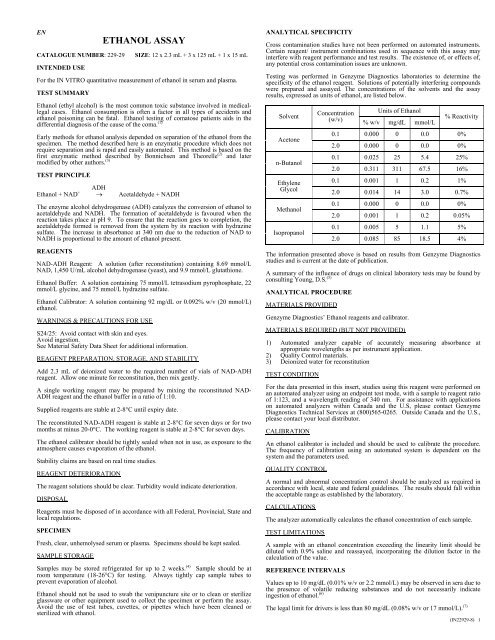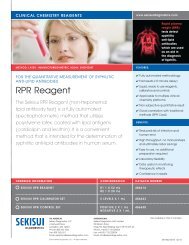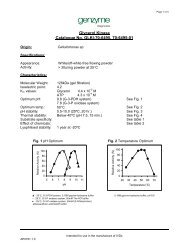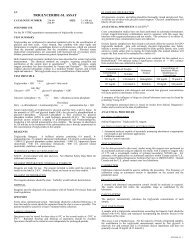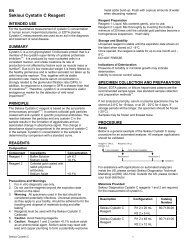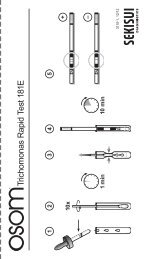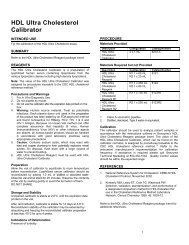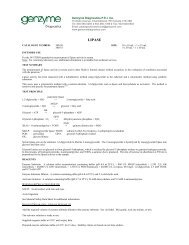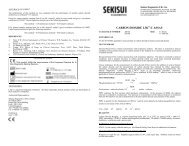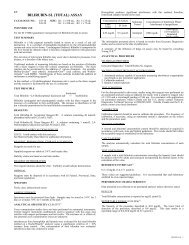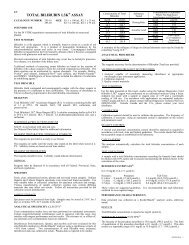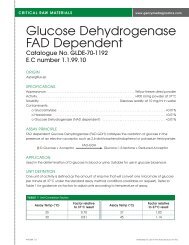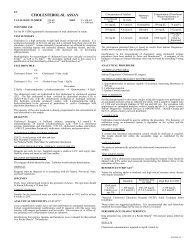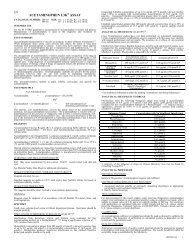ETHANOL ASSAY - Sekisui Diagnostics
ETHANOL ASSAY - Sekisui Diagnostics
ETHANOL ASSAY - Sekisui Diagnostics
- No tags were found...
You also want an ePaper? Increase the reach of your titles
YUMPU automatically turns print PDFs into web optimized ePapers that Google loves.
ENCATALOGUE NUMBER: 229-29INTENDED USE<strong>ETHANOL</strong> <strong>ASSAY</strong>SIZE: 12 x 2.3 mL + 3 x 125 mL + 1 x 15 mLFor the IN VITRO quantitative measurement of ethanol in serum and plasma.TEST SUMMARYEthanol (ethyl alcohol) is the most common toxic substance involved in medicallegalcases. Ethanol consumption is often a factor in all types of accidents andethanol poisoning can be fatal. Ethanol testing of comatose patients aids in thedifferential diagnosis of the cause of the coma. (1)Early methods for ethanol analysis depended on separation of the ethanol from thespecimen. The method described here is an enzymatic procedure which does notrequire separation and is rapid and easily automated. This method is based on thefirst enzymatic method described by Bonnichsen and Theorelle (2) and latermodified by other authors. (3)TEST PRINCIPLEADHEthanol + NAD + → Acetaldehyde + NADHThe enzyme alcohol dehydrogenase (ADH) catalyzes the conversion of ethanol toacetaldehyde and NADH. The formation of acetaldehyde is favoured when thereaction takes place at pH 9. To ensure that the reaction goes to completion, theacetaldehyde formed is removed from the system by its reaction with hydrazinesulfate. The increase in absorbance at 340 nm due to the reduction of NAD toNADH is proportional to the amount of ethanol present.REAGENTSNAD-ADH Reagent: A solution (after reconstitution) containing 8.69 mmol/LNAD, 1,450 U/mL alcohol dehydrogenase (yeast), and 9.9 mmol/L glutathione.Ethanol Buffer: A solution containing 75 mmol/L tetrasodium pyrophosphate, 22mmol/L glycine, and 75 mmol/L hydrazine sulfate.Ethanol Calibrator: A solution containing 92 mg/dL or 0.092% w/v (20 mmol/L)ethanol.WARNINGS & PRECAUTIONS FOR USES24/25: Avoid contact with skin and eyes.Avoid ingestion.See Material Safety Data Sheet for additional information.REAGENT PREPARATION, STORAGE, AND STABILITYAdd 2.3 mL of deionized water to the required number of vials of NAD-ADHreagent. Allow one minute for reconstitution, then mix gently.A single working reagent may be prepared by mixing the reconstituted NAD-ADH reagent and the ethanol buffer in a ratio of 1:10.Supplied reagents are stable at 2-8°C until expiry date.The reconstituted NAD-ADH reagent is stable at 2-8°C for seven days or for twomonths at minus 20-0°C. The working reagent is stable at 2-8°C for seven days.The ethanol calibrator should be tightly sealed when not in use, as exposure to theatmosphere causes evaporation of the ethanol.Stability claims are based on real time studies.REAGENT DETERIORATIONThe reagent solutions should be clear. Turbidity would indicate deterioration.DISPOSALReagents must be disposed of in accordance with all Federal, Provincial, State andlocal regulations.SPECIMENFresh, clear, unhemolysed serum or plasma. Specimens should be kept sealed.SAMPLE STORAGESamples may be stored refrigerated for up to 2 weeks. (4) Sample should be atroom temperature (18-26°C) for testing. Always tightly cap sample tubes toprevent evaporation of alcohol.Ethanol should not be used to swab the venipuncture site or to clean or sterilizeglassware or other equipment used to collect the specimen or perform the assay.Avoid the use of test tubes, cuvettes, or pipettes which have been cleaned orsterilized with ethanol.ANALYTICAL SPECIFICITYCross contamination studies have not been performed on automated instruments.Certain reagent/ instrument combinations used in sequence with this assay mayinterfere with reagent performance and test results. The existence of, or effects of,any potential cross contamination issues are unknown.Testing was performed in Genzyme <strong>Diagnostics</strong> laboratories to determine thespecificity of the ethanol reagent. Solutions of potentially interfering compoundswere prepared and assayed. The concentrations of the solvents and the assayresults, expressed as units of ethanol, are listed below.SolventAcetonen-ButanolEthyleneGlycolMethanolIsopropanolConcentration(w/v)Units of Ethanol% w/v mg/dL mmol/L% Reactivity0.1 0.000 0 0.0 0%2.0 0.000 0 0.0 0%0.1 0.025 25 5.4 25%2.0 0.311 311 67.5 16%0.1 0.001 1 0.2 1%2.0 0.014 14 3.0 0.7%0.1 0.000 0 0.0 0%2.0 0.001 1 0.2 0.05%0.1 0.005 5 1.1 5%2.0 0.085 85 18.5 4%The information presented above is based on results from Genzyme <strong>Diagnostics</strong>studies and is current at the date of publication.A summary of the influence of drugs on clinical laboratory tests may be found byconsulting Young, D.S. (5)ANALYTICAL PROCEDUREMATERIALS PROVIDEDGenzyme <strong>Diagnostics</strong>’ Ethanol reagents and calibrator.MATERIALS REQUIRED (BUT NOT PROVIDED)1) Automated analyzer capable of accurately measuring absorbance atappropriate wavelengths as per instrument application.2) Quality Control materials.3) Deionized water for reconstitutionTEST CONDITIONFor the data presented in this insert, studies using this reagent were performed onan automated analyzer using an endpoint test mode, with a sample to reagent ratioof 1:123, and a wavelength reading of 340 nm. For assistance with applicationson automated analyzers within Canada and the U.S, please contact Genzyme<strong>Diagnostics</strong> Technical Services at (800)565-0265. Outside Canada and the U.S.,please contact your local distributor.CALIBRATIONAn ethanol calibrator is included and should be used to calibrate the procedure.The frequency of calibration using an automated system is dependent on thesystem and the parameters used.QUALITY CONTROLA normal and abnormal concentration control should be analyzed as required inaccordance with local, state and federal guidelines. The results should fall withinthe acceptable range as established by the laboratory.CALCULATIONSThe analyzer automatically calculates the ethanol concentration of each sample.TEST LIMITATIONSA sample with an ethanol concentration exceeding the linearity limit should bediluted with 0.9% saline and reassayed, incorporating the dilution factor in thecalculation of the value.REFERENCE INTERVALSValues up to 10 mg/dL (0.01% w/v or 2.2 mmol/L) may be observed in sera due tothe presence of volatile reducing substances and do not necessarily indicateingestion of ethanol. (6)The legal limit for drivers is less than 80 mg/dL (0.08% w/v or 17 mmol/L). (7)(IN22929-8) 1
These values are suggested guidelines. It is recommended that each laboratoryestablish its own expected range.PERFORMANCE CHARACTERISTICSRESULTSEthanol concentration is reported as mg/dL (% w/v or mmol/L).REPORTABLE RANGEThe linearity of the procedure described is 230 mg/dL (0.23% or 50 mmol/L).PRECISION STUDIESDay to day precision was established by assaying three spiked pooled sera twice aday for 10 days.Concentration Total SDTotalConcentrationWithin RunSDCV %mg/dL mmol/L mg/dL mmol/L mg/dL mmol/L mg/dL mmol/LWithinRunCV %52 11.3 0.8 0.17 1.5 50 10.9 0.3 0.07 0.697 21.1 2.2 0.48 2.3 99 21.5 1.1 0.24 1.1137 29.7 3.4 0.74 2.5 150 32.6 7.0 1.52 4.7Within day precision was established by assaying three spiked sera twenty times.ACCURACY (Serum)The performance of this method (y) was compared with the performance of asimilar UV alcohol dehydrogenase method (x). Linear regression analysis gavethe following equation:This method = 0.991 (reference method) + 1.2 mg/dL or 0.0012% w/v (0.26mmol/L).ACCURACY (Plasma)The performance of this method (y) was compared with the performance of asimilar UV alcohol dehydrogenase method (x). Linear regression analysis gavethe following equation:This method = 0.9984 (reference method) - 1.2 mg/dL or 0.0012% w/v (0.26mmol/L).The information presented above is based on results from Genzyme <strong>Diagnostics</strong>studies and is current at the date of publication.TRADEMARKSAll trademarks, brands, product names and trade names are the property of theirrespective companies.Manufactured by:The AmericasInternationalGenzyme <strong>Diagnostics</strong> P.E.I. Inc. Genzyme <strong>Diagnostics</strong>70 Watts Avenue 50 Gibson DriveCharlottetown, PE C1E 2B9Kings Hill, West MallingCanadaKENT, ME19 4AF, UKPhone: 800-565-0265Email: ukdiagcustomerserviceFax: 902-628-6504@genzyme.comEmail: customerservice@genzyme.compeidiagnostictechnical@genzyme.comwww.genzymediagnostics.comESNÚMERO DE CATÁLOGO: 229-29ANÁLISIS DE ETANOLUSO PARA EL QUE FUE DISEÑADOTAMAÑO: 12 x 2.3 ml + 3 x 125 ml + 1 x 15 mlPara la medición cuantitativa IN VITRO de etanol en suero y en plasma.RESUMEN DEL ANÁLISISEl etanol (alcohol etílico) es la substancia tóxica que se halla con mayorfrecuencia en los casos de medicina forense. El consumo de etanol es a menudoun factor determinante en todo tipo de accidente, y el envenenamiento con etanolpuede ser fatal. Los análisis del etanol en pacientes en estado comatoso ayudan enel diagnóstico diferencial de la causa del coma. (1)Los métodos usados anteriormente para el análisis del etanol dependían de laseparación del etanol de la muestra. El método de análisis aquí descrito es unprocedimiento enzimático para el que no se necesita la separación, y se puedeautomatizar fácil y rápidamente. Este método se funda en el primer métodoenzimático descrito por Bonnichsen y Theorelle (2) y que fue modificadoposteriormente por otros autores. (3)PRINCIPIO DEL ANÁLISISADHEtanol + NAD + → Acetaldehído + NADHLa enzima alcohol deshidrogenasa (ADH) cataliza la conversión del etanol enacetaldehído y NADH. La formación de acetaldehído se ve favorecida cuando lareacción se produce a un pH de 9. Para garantizar que la reacción se complete, elacetaldehído formado se retira del sistema mediante su reacción con el sulfato dehidrazina. El aumento de la absorbencia a 340 nm debido a la reducción del NADa NADH es proporcional a la cantidad de etanol presente.AGENTES REACTIVOSAgente reactivo de NAD-ADH: Una solución (tras su reconstitución) que contiene8.69 mmol/l de NAD, 1,450 u/ml de alcohol deshidrogenasa (levadura) y 9.9mmol/l de glutatión.Tampón de etanol: Una solución que contiene 75 mmol/l de pirofosfatotetrasódico, 22 mmol/l de glicina y 75 mmol/l de sulfato de hidrazina.Calibrador de etanol: Una solución que contiene 92 mg/dl o 0.092% p/v (20mmol/l) de etanol.ADVERTENCIAS Y MEDIDAS DE PRECAUCIÓN PARA SU USOS24/25: Evite el contacto con la piel y los ojos.Evite la ingestión.Para obtener mayor información, lea la hoja de datos de seguridad de materiales.PREPARACIÓN, ALMACENAMIENTO Y ESTABILIDAD DEL AGENTEREACTIVOAñada 2.3 ml de agua desionizada al número requerido de frascos del agentereactivo de NAD-ADH. Deje pasar un minuto para que se reconstituya, luegomézclelo ligeramente.Un solo agente de reacción de trabajo puede prepararse mezclando el agentereactivo de NAD-ADH reconstituido con el tampón de etanol en una proporciónde 1:10.El agente reactivo que se suministra es estable hasta la fecha de caducidad, a unatemperatura de 2 a 8°C.El agente reactivo de NAD-ADH reconstituido es estable durante siete días a unatemperatura de 2 a 8°C o durante dos meses a una temperatura de menos 20 a 0°C.El agente reactivo de trabajo es estable durante siete días a una temperatura de 2 a8°C.El calibrador de etanol debe estar herméticamente cerrado cuando no se emplee,pues su exposición a la atmósfera produce la evaporación del etanol.Las afirmaciones acerca de la estabilidad se fundan en estudios realizados entiempo real.DETERIORO DEL AGENTE REACTIVOEl agente reactivo debe ser transparente. La turbidez podría ser una indicación dedeterioro.ELIMINACIÓNLos agentes reactivos se deben eliminar de acuerdo con las estipulaciones de lasnormas federales, provinciales, estatales y locales.MUESTRAMuestra de suero o plasma recién sacado, transparente, sin hemolizar. Lasmuestras deben conservarse bien cerradas.(IN22929-8) 2


